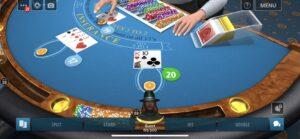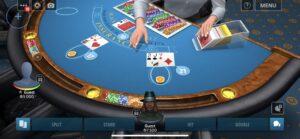
Core Aesthetics
Blackjack is interesting because despite playing at the same table, players are competing against the house, and not the people sitting beside/across from them. This mechanic sets up a dynamic where at times, when I played, it almost felt like it was us against the house: we could see each other’s cards and advise on whether to “hit” or to “stand” to best the house. This is in stark contrast to poker games where one player’s luck, and their ability to effectively employ strategy is detrimental to the next player’s success. There, competition is a key core aesthetic whereas here, fellowship could be an aesthetic – perhaps not critical, but not un-noteworthy that might attract some players such as myself.
Submission is a core aesthetic of Blackjack. The rounds are short and rapid which makes it easier to build up a winning or losing streak where the player is motivated to continue either because they want the reward of continued victory, or because they’re lulled into the sense that they’re due for a victory soon. The mechanic of trying to get as close as possible to 21 also builds on this because it is a simple enough premise that the player can zone out as they play, and act on muscle memory. There is also something striking about coming so close to winning in one round (as I did often, having a 19, but being bested by a 20) that encourages the player to play again, because perhaps this time, they can get even closer, or win.

While these mechanics and dynamics create a fun experience for the player, it also does put them at risk of addiction. Rapid rounds mean rapid and instantaneous reward releases that create a positive feedback loop. Getting stuck in this loop of abnegation, feeling like you’re close to a victory or wanting to experience frequent rewards can have long term detrimental effects.
Blackjack vs. other games of Chance
The rapidness of the game means that interaction loops also cycle through quickly. As the player continues to observe how often they go bust after “hitting” at certain scores (e.g., going bust after “hitting” at 15 or 17) they start to build an intuitive mental model of the probability of reaching blackjack. This makes the decision-making process easier (for casual players) in that they don’t have to do progressively less mental computation trying to figure out probabilities and can fall into the flow of “hitting” or “standing” based on intuition.

In poker games like Texas Hold Em, building this mental model is arguably more challenging especially with rounds where the player doesn’t have an obviously bad hand. This is because here there are more datapoints to consider: players are in multilateral competition (vs I would argue player vs. game in Blackjack), and the mechanics are set up such that dynamics like bluffing make building strategy a much more involved process – especially for casual players such as myself. In short, navigating the elements of probability and chance feel much easier in Blackjack.



